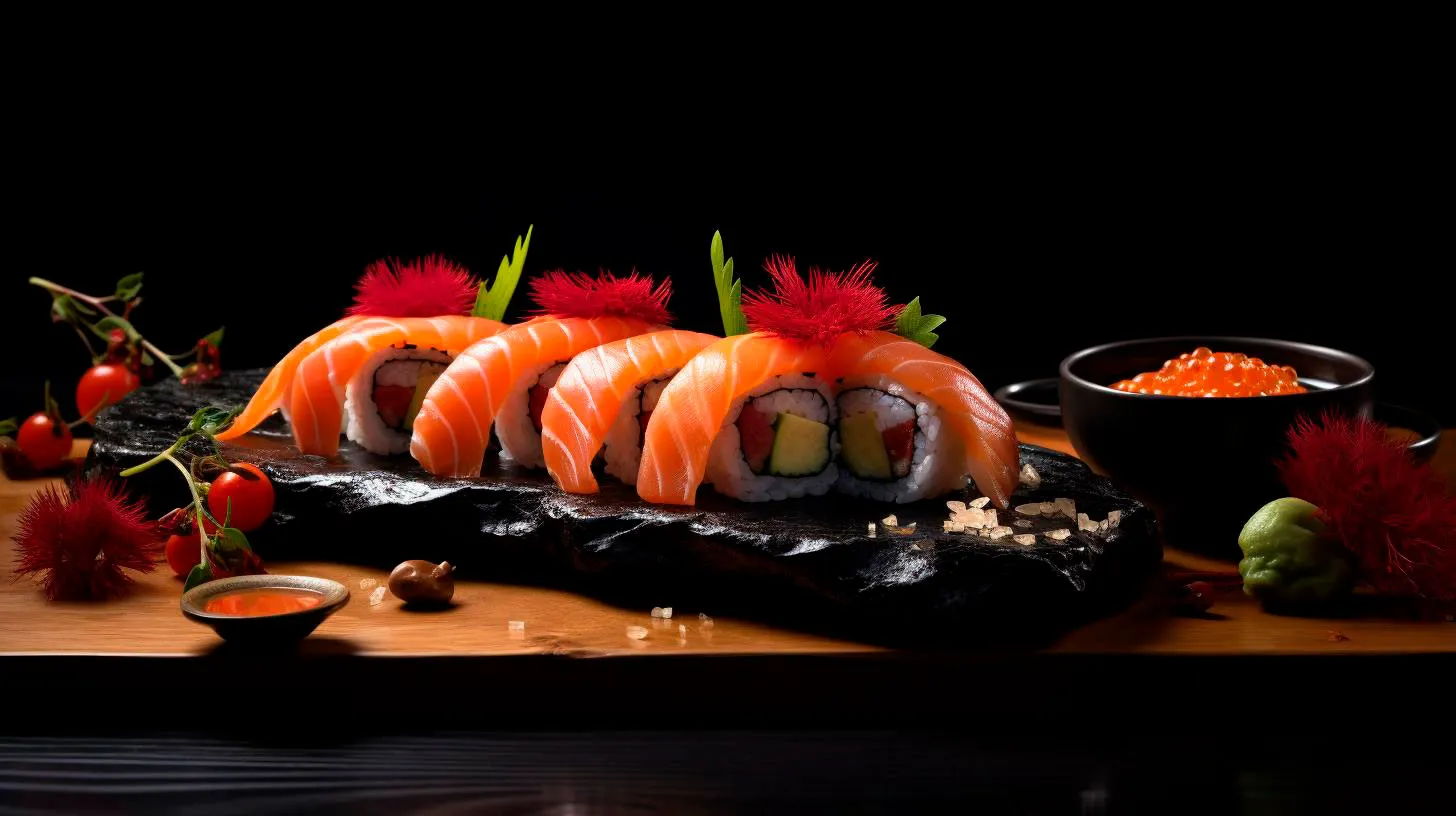The Role of Artificial Intelligence in Sushi Making
In this blog post, we will explore the role of AI in sushi making, its benefits, and its impact on the culinary industry.
Automating Sushi Preparation
Traditionally, sushi making requires years of training and expertise to master the art. However, AI-powered machines are rapidly changing the game by automating the sushi preparation process. These machines are equipped with AI algorithms that can mimic the skills of a sushi chef, from slicing fish to perfectly forming the rice.
Key Takeaway:
- AI-powered machines automate the process of sushi preparation, mimicking the skills of a sushi chef.
Enhanced Efficiency and Precision
AI offers enhanced efficiency and precision in sushi making. These machines can consistently produce perfectly shaped nigiri or maki rolls, eliminating variations that often occur due to human error. By utilizing computer vision and machine learning algorithms, AI can analyze and reproduce the exact technique and presentation of the most skilled sushi chefs.
Moreover, AI-powered machines can work at a much faster pace than humans, significantly increasing production capacity. This is essential for sushi restaurants experiencing high demand, ensuring quick and efficient service.
Key Takeaways:
- AI ensures consistent and precise sushi production, eliminating variations caused by human error.
- Computer vision and machine learning algorithms enable AI to replicate the skills and technique of skilled sushi chefs.
- AI-powered machines increase production capacity, providing quick and efficient service in high-demand situations.
Quality Control and Food Safety
Food safety is of utmost importance in the culinary industry. AI plays a crucial role in ensuring the quality and safety of sushi. AI-powered machines can analyze the freshness of fish and seafood, detecting any potential contaminants or spoilage. By accurately monitoring temperature and humidity levels, these machines can prevent the growth of harmful bacteria, ensuring that sushi maintains its freshness and quality.
In addition, AI can assist in reducing food waste by optimizing ingredient usage. By accurately measuring and portioning ingredients, AI-powered machines can minimize unnecessary waste, leading to cost savings for sushi restaurants.
Key Takeaways:
- AI technology helps in analyzing and maintaining the freshness and quality of sushi.
- AI-powered machines monitor temperature and humidity levels to prevent the growth of harmful bacteria.
- AI minimizes food waste by optimizing ingredient usage, leading to cost savings.
Personalization and Menu Innovation
Thanks to AI, sushi restaurants can now offer a greater degree of personalization to their customers. AI algorithms can gather data on customer preferences, such as favorite flavors, ingredients, or dietary restrictions. This information can then be used to create customized sushi options, ensuring a personalized dining experience.
Furthermore, AI can aid in the creation of innovative sushi recipes. By analyzing patterns and trends in customer preferences, AI algorithms can suggest unique flavor combinations and new culinary creations. This allows sushi chefs to experiment and create exciting dishes that cater to evolving consumer tastes.
Key Takeaways:
- AI enables personalized sushi options based on customer preferences.
- AI algorithms can suggest innovative flavor combinations and new culinary creations.
- Sushi chefs can experiment and create exciting dishes to cater to evolving consumer tastes
The Future of Sushi Making
The integration of AI in sushi making is just the beginning. As technology continues to evolve, we can expect further advancements in the culinary industry. The future of sushi making may involve even more sophisticated AI-powered machines, capable of replicating the creativity and intuition of talented sushi chefs.
However, it’s important to note that AI can never fully replace the craftsmanship and artistry of human sushi chefs. The true essence of sushi lies in the ability to combine skill, passion, and creativity. AI can certainly enhance and streamline the sushi-making process, but the human touch will forever remain an integral part of this beloved cuisine.
Key Takeaway:
- The future of sushi making may involve even more advanced AI-powered machines.
- While AI enhances and streamlines the process, human craftsmanship and creativity remain essential to sushi making.
In conclusion, AI technology is transforming the world of sushi making. It brings automation, precision, and efficiency to the process while ensuring food safety and offering personalization and menu innovation. Although AI evolves, it can never replace the heart and soul that sushi chefs put into their creations. As we look ahead, we can anticipate a future where AI and human expertise work hand-in-hand to deliver exceptional sushi experiences. So, the next time you enjoy a plate of sushi, take a moment to appreciate the fusion of technology and tradition that has made it possible.
How Artificial Intelligence is Transforming Sushi Production
In this article, we will explore how AI is transforming sushi production and the benefits it brings to both the industry and consumers.
The Rise of AI in Sushi Production
Artificial intelligence technology is making its way into sushi kitchens around the world. Traditionally, making sushi has relied heavily on the expertise and experience of sushi chefs. However, AI is now being used to automate and streamline various aspects of the sushi production process, from ingredient selection to sushi roll assembly.
One of the key areas where AI is making a significant impact is in the evaluation of fish quality. AI-powered systems can analyze various factors like color, texture, and freshness to determine the quality of fish. This not only ensures consistent quality but also reduces the risk of serving subpar sushi to customers. With AI, sushi chefs can make more informed decisions about ingredient selection, resulting in a better dining experience for customers.
Another area where AI is transforming sushi production is in the automation of sushi roll assembly. Sushi-making robots are now equipped with AI algorithms that can precisely measure and distribute the perfect amount of rice and toppings. These robots can create perfectly rolled sushi consistently, reducing the dependency on skilled sushi chefs and increasing production efficiency.
Advantages of AI in Sushi Production
The integration of AI in sushi production comes with several advantages for both businesses and consumers:
- Consistent Quality: AI-powered systems can analyze fish quality with a high level of precision, ensuring consistent quality across every sushi roll.
- Increased Efficiency: Sushi-making robots equipped with AI algorithms can roll sushi at a much faster rate than human chefs, allowing for higher production capacity.
- Reduced Costs: With the automation of certain tasks, businesses can reduce labor costs and allocate resources more efficiently.
- Improved Food Safety: AI can help identify potential contaminants or spoilage in ingredients, minimizing the risk of foodborne illnesses.
- Enhanced Creativity: Sushi chefs can focus on developing new and innovative sushi recipes, as AI takes care of repetitive and time-consuming tasks.
The Future of AI in Sushi Production
The implementation of AI in sushi production is just the beginning. As technology continues to advance, we can expect further innovations and developments in this field. Here are some potential future advancements:
- Personalized Sushi: AI algorithms could be used to analyze customer data and preferences to create personalized sushi rolls tailored to individual tastes.
- Smart Sushi Kiosks: AI-powered sushi kiosks could automate the entire ordering process, allowing customers to customize their rolls and receive them within minutes.
- Real-time Ingredient Monitoring: AI-based systems could monitor ingredient inventory in real-time, alerting chefs when supplies run low and optimizing ingredient ordering.
- Waste Reduction: By analyzing sales data and customer preferences, AI could optimize ingredient usage, reducing food waste in sushi production.
Key Takeaways
Artificial intelligence is revolutionizing sushi production by automating processes and providing valuable insights to sushi chefs. The integration of AI ensures consistent quality, increases efficiency, reduces costs, and enhances food safety in sushi production. As technology evolves, we can expect AI to further personalize the sushi experience and streamline operations. With AI, the sushi industry is embracing innovation while maintaining the artistry and tradition of sushi-making.
Implementing AI to Revolutionize Sushi Preparation
Considering the increasing demand for sushi in restaurants and takeaway joints, it is essential to explore ways to streamline the sushi-making process while maintaining its authenticity. This is where the implementation of artificial intelligence (AI) can revolutionize sushi preparation, allowing for enhanced efficiency, consistency, and quality in every bite.
The Role of AI in Sushi Preparation
Traditionally, sushi chefs spend years honing their skills to achieve the delicate balance of taste, texture, and aesthetics that make sushi so desirable. However, with the advent of AI technology, the precision and consistency of sushi preparation can be greatly improved. By leveraging AI algorithms, sushi chefs can now create standardized sushi rolls without compromising on taste or presentation.
Key Advantages of AI in Sushi Preparation:
- Enhanced precision: AI algorithms can calculate the exact measurements required for each ingredient, ensuring consistent proportions for every sushi roll produced.
- Improved efficiency: With AI-enabled machines, sushi chefs can automate repetitive tasks, such as rice spreading and rolling, allowing them to focus on more complex techniques and creative aspects of sushi-making.
- Consistency: AI-powered sushi machines can replicate the same sushi roll repeatedly, guaranteeing a consistent taste and appearance, regardless of the chef’s experience or skill level.
- Optimized ingredient usage: AI algorithms can optimize ingredient utilization, reducing waste and increasing cost-effectiveness for sushi restaurants.
- Reduced training time: By utilizing AI in sushi preparation, aspiring sushi chefs can benefit from a reduced learning curve, as AI algorithms provide guidance and assistance throughout the process.
Industry Statistics Supporting the Adoption of AI in Sushi Preparation
According to a report by Technomic, a leading food industry research firm, the global sushi market is projected to reach $22.7 billion by 2026, with a compound annual growth rate (CAGR) of 3.7%. This steady growth indicates a rising demand for sushi, prompting the need to optimize production processes and enhance efficiency. By adopting AI in sushi preparation, restaurants can meet the increasing demand while maintaining the quality and consistency that customers expect.
Furthermore, a survey conducted by the Japan External Trade Organization (JETRO) revealed that the shortage of skilled sushi chefs is a significant challenge faced by the industry. By integrating AI into the sushi-making process, restaurants can mitigate this issue and ensure a consistent supply of high-quality sushi, irrespective of the availability of skilled chefs.
Key Takeaways
Implementing AI in sushi preparation has proven to be a game-changer for the industry, offering numerous benefits that contribute to customer satisfaction, cost-effectiveness, and consistency. Here are the key takeaways from this revolutionizing technology:
- AI enhances precision by calculating exact ingredient measurements.
- Efficiency is improved through automation of repetitive tasks.
- Consistency is guaranteed, regardless of the chef’s skill level.
- Ingredient waste is minimized, optimizing cost-effectiveness.
- Training time for sushi chefs is reduced, ensuring a consistent supply of skilled professionals.
As the global sushi market continues to grow, embracing AI in sushi preparation is a strategic move for sushi restaurants looking to stay ahead of the curve. By combining the artistry of sushi-making with the efficiency of AI technology, the future of sushi preparation is undoubtedly bright, delivering consistent, high-quality sushi with every bite.
Exploring the Advancements of AI in the Sushi Industry
In this article, we will dive into the exciting developments in AI that are reshaping the sushi industry.
The Rise of AI in Sushi Preparation
Gone are the days when sushi chefs had to spend years mastering the art of sushi-making. AI is now enhancing the sushi preparation process, bringing precision and efficiency to the kitchen. Here’s how:
- Automated Ingredient Sourcing: AI-powered robots are capable of selecting the freshest and highest-quality ingredients for sushi preparation. These robots use visual recognition technology to analyze various factors such as color, texture, and freshness, ensuring every sushi roll meets the highest standards.
- Perfectly Rolled Sushi: With the help of AI, robots can expertly roll sushi with consistent precision. These machines are programmed to create perfectly shaped rolls, eliminating any inconsistencies that human hands might introduce. This ensures that each sushi roll looks and tastes impeccable.
- Accurate Portion Control: AI-powered machines ensure accurate portion control, making sure that the amount of fish, rice, nori, and other ingredients in each sushi roll is precisely measured. This not only ensures uniformity but also reduces food waste, making sushi preparation more sustainable.
Revolutionizing the Sushi Dining Experience
AI is not limited to the back-of-house operations; it is also reshaping the way sushi is served and enjoyed by diners. Let’s explore how AI is revolutionizing the sushi dining experience:
- Personalized Recommendations: AI-powered systems can analyze customer preferences, past orders, and even external data such as weather and trends to provide personalized sushi recommendations. This enhances the dining experience by suggesting sushi rolls that match individual tastes and preferences.
- Interactive Ordering: Some sushi restaurants are incorporating AI-powered tablets or kiosks for ordering. These user-friendly devices allow customers to browse through a digital menu, customize their orders, and even visualize how their sushi rolls will look before placing the order. This interactive ordering experience enhances customer engagement and satisfaction.
- Real-time Feedback: AI can capture real-time feedback from customers, allowing sushi restaurants to continuously improve their offerings. By analyzing customer feedback patterns, restaurants can identify popular dishes, tweak recipes, and adapt to changing customer preferences, ensuring a top-notch dining experience.
Key Takeaways: AI Advancements in the Sushi Industry
As AI continues to evolve, it is set to transform the sushi industry in numerous ways. Here are the key takeaways:
- AI is streamlining sushi preparation by automating ingredient sourcing, perfecting sushi rolls, and ensuring accurate portion control.
- AI-powered systems are enhancing the sushi dining experience by providing personalized recommendations and interactive ordering.
- Real-time feedback captured by AI helps sushi restaurants improve their offerings and keep up with changing customer preferences.
With AI-powered robots and systems becoming increasingly prevalent in the sushi industry, we can expect more efficient sushi preparation and an elevated dining experience for sushi enthusiasts worldwide. Embracing these advancements will not only benefit sushi chefs and restaurant owners but also revolutionize the way we enjoy this beloved Japanese delicacy.



